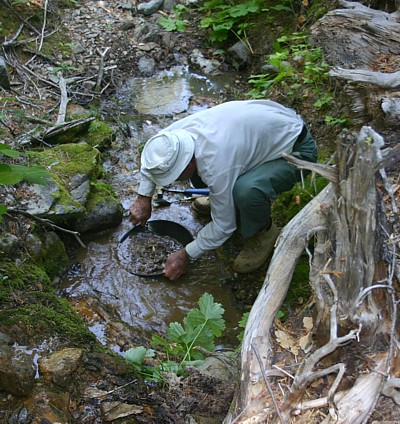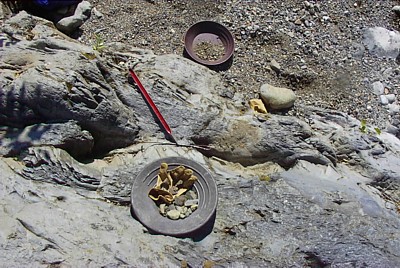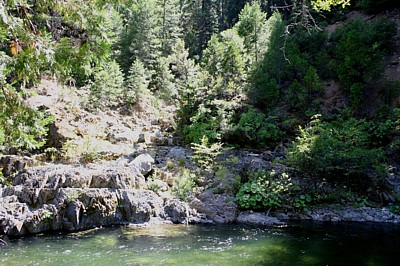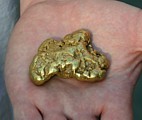|
|
|
|
There's a lot of really great
prospecting equipment on the market right now, and I have to admit I’ve
spent my share of money over the years investing in dredges, dry washers,
metal detectors and the like. But a lot of new folks just getting into
prospecting don't want to start out by spending a bundle just to see if they
will really enjoy it. They want to know “Do I need to spend a mint buying
equipment just to try it out?”
Well, the truth is that you can spend
just about as much or as little as you want – remember that the bottom line
goal in all of this, beyond finding some gold, is to have fun. You can get a
decent plastic pan for around $10, and with a screwdriver and other tools
from home, you are ready to begin your quest for gold. On the other hand, a
top of the line metal detector with a few normal accessories be over $4000
and a large dredge with diving equipment can cost far more. There are also
lots of possible alternatives between these two extremes. It is normal that
new prospectors start slow and buy a few inexpensive items – try it out and
see if you enjoy it. It makes sense to master the basics first. There are
even some tools and equipment that it is possible to make for ones self if
you have some experience in fabricating things.
So I’d advise a slow going type of
approach. Don’t start by spending a mint on equipment even if you can
afford it. It makes sense to let your equipment inventory grow in tandem
with your experience. Buy a gold pan and maybe a try bar or a crevice tool,
then join a club and learn about prospecting first. Joining a club can
give you access to
places to prospect and a chance to talk about local places to look,
regulations and what really works to get gold in your neck of the woods. All
these things are really important to the new prospector. It will also give
you a chance to meet some folks with more experience than you have.
Attend
club meetings, go
out on club field trips and learn how to find gold and prospect, and talk to
the local guys in
the club and see
what they know about finding gold in your area.
For those who live out west, there
are many choices of clubs, but GPAA is the only one which is close to
nationwide in its scope.
Although
reading books, searching the Internet and other forms of armchair learning
are great, nothing substitutes for getting out in the field and really doing
it. Spend some time in the field and see how you like prospecting, then if
you are still gung ho about it you will have learned lots more in the mean
time and be able to make a very well informed decision on what kinds of
equipment you might want to buy. |
|
Start out small and build up – many long
time prospectors acquire quite a load of various types of prospecting
equipment (you should take a look at my garage!). If you take your time you
can learn what works in your area and what types of prospecting you enjoy
before you spend too much money. A lot of prospecting can be done with just
a simple pan. Even if you are in the desert you can dig and screen and pan
the material out in a tub with water you have brought to the site.
As I've mentioned previously, there are
some types of equipment one can build at home. Simple sluice boxes come to
my mind, but I have seen well-built high bankers, dry washers and even
dredges. A simple sluice box will allow you to process a lot more gravel and
it is something that even a beginner could try to build. There are plans
available in books and on the Internet -- and prospectors have been building
their own sluices for centuries. A sluice box can be built of wood, but
things like dredges and dry washers are a bit more complex. If you are
going to attempt something more advanced, you ought to have good welding and
metal fabrication skills, access to the necessary metal working equipment,
and a very good understanding of how the device works. This is because I
have also seen homemade equipment doomed to fail because the maker either
cut corners or did not fully understand the nature of how the device really
operates. Examine closely the commercial units that are for sale -- this
can tell you lots about how you ought to construct any homemade device. |
 |
|
Folks new to this great pastime need
to know that prospecting is, in a lot of ways, like a trade. There is a lot
to learn and it takes time to learn what to do in different situations, how
to read a river, what characteristics are important to see in the quartz on
the surface of the desert floor, the color of the soil or a dozen other
indicators that might point out the best places to start looking for gold.
There are procedures to learn which are time-tested to yield good results.
The more you know and the more experience you have, in general the more gold
you will recover, and like a trade, it is a skill that takes time and effort
to learn. So relax, because no one ever learns it all, and you won't gain
the decades of experience the old-timers possess in just a few days or
weeks.
The simple pan and the individual
prospector go hand-in-hand -- it is tradition. The inexpensive pan has long
been the standard piece of prospecting equipment carried by old timers since
the first great gold rushes in the United States. It's been used to look
for hard rock gold and placers in mountain streams and in deserts far and
wide. In the past, most pans were made of metal and on long exposure to
water, they had a big tendency to rust. You can still buy metal pans, and I
do own a couple of them myself, but the pans I use normally are all made of
plastic. Plastic pans are cheap, durable and they don't rust. Unless you
drop a big boulder on one, they will last for many years. For most new
prospectors a plastic pan should be the first piece of prospecting equipment
they purchase, and panning should be the first prospecting technique they
learn to master. The basic idea of panning is that by shaking and moving the
pan around, the gold which is so much heavier than the sand, will settle out
downward to the bottom of the pan. Lighter sand and gravel can then be
washed off the surface out of the pan. The process of shaking and washing
off the lighter material continues until only a small concentrate of heavy
materials remain. Here are my
Instructions For Gold Panning |
|
|
. |
|
In theory, it is possible to pan
material without water -- but in reality it doesn't work very well. Water
makes the process of separating waste gravel from gold much, much easier.
There is no doubt that dry panning is a difficult art to master. In many
places where heavy clay is present, it can be virtually impossible to
effectively dry pan placer gravels. Gold gets locked up in clods with the
clay, and won't settle to the bottom of the pan the way it should. Any real
acceptable success at dry panning requires that the material be screened,
very dry and contain little or no clay. This is why it is much more common
for desert prospectors who are sampling and sniping around to bring in water
in buckets or other containers and pan collected material within a tub.
This allows the prospector to get reasonably good effectiveness and
recovering any fine gold that is present in the gravels which is collected.
Bringing along water in a tub can be a logistical pain in the behind but it
does work.
The importance of small screens and
testing of sniping using hand methods is hard to overemphasize. When
digging by hand, it's easy to produce a lot of material that may have to be
carried to water and panned. Screening out the coarser gravel and rocks is
much faster than picking them out by hand and allows the prospector to focus
in on smaller gravel and sands which are usually more likely to contain
gold. Except when heavily coated with Clay and iron staining most nuggets
that are too large to go through the screen will be easily visible and the
average prospector won't miss seeing them. |
 |
|
When you are looking for a place to pan,
you are often looking for cracks and crevices in the bedrock of a stream. A
pan is not a high volume piece of processing equipment, and so you are
looking for small quantities of richer material. Since gold works its way
downward in many cases, cracks and crevices become catch holds for gold.
The pan is the tool of choice for
testing out new locations - and it is important to remember that not enough
testing is done! One of the most important lessons for old and new
prospectors alike is that it is hard to be successful without lots of
sampling on a regular basis. Rarely does gold occur in consistent and even
concentrations throughout an area. Normally gold is spotty and can be rich
in one place and only a few feet away be virtually barren -- this is the
reason why lots of sampling has to be done because there are a whole lot
more low-grade spots that high grade ones. You want to keep looking until
you find those good spots! Don't hunker down and just keep digging in a spot
where there is no gold – if you don’t find it, you’ve got to move on! If you
find a spot with a fairly large amount of gravel that yields well you might
want to consider bringing in a sluice box. Slucing is a step up in that it
will allow you to process a lot more material per hour than you could
possibly pan. If the location is dry, perhaps a dry washer would be the way
to increase production.
In many ways sniping and prospecting
with hand tool has almost become lost art with so much great equipment
available, dredges, metal detectors, dry washers and the like. It just
becomes too easy to get caught up in all a great opportunities that these
equipment items offer to us. It's important to remember that simply breaking
open small cracks and crevices and exposed bedrock can still yield some
fairly nice nuggets. Crevicing and sniping can be done even in the desert
simply by following exposed and shallow bedrock and blowing or brooming off
the surface of the rock and collecting material. Any crevices in the bedrock
exposed by doing this should be carefully cleaned out. Small nuggets can be
exposed or materials from inside those cracks can be collected for later
panning. |
|
While most people will do the bulk of
their prospecting above the water line or in dry areas, it's important to
remember that crevicing can be done both above the water line and below.
Underwater crevicing is basically an art in itself -- there are prospectors
who specialize in this type of work because it can be very productive.
Really the only tools necessary are wetsuit, mask, snorkel, and tools like a
pry bar for cleaning out crevices. A pair of tweezers and a specimen
bottle to hold your gold is also worthwhile -- other than the wetsuit, all
these are inexpensive items. The advantage of underwater crevices is that
they get a whole lot less attention than their more easily reached brethren
above the water line. Just last summer while dredging at a spot that serves
as the local swimming hole for the town youth, I picked out a quarter ounce
nugget exposed to sunlight but about 18 inches below the surface of the
water. I guarantee that quarter ounce nuggets above the water line that can
be seen by the eye get picked up rather quickly. That little spot of
bedrock below the water line had just never really been thoroughly explored
in spite of the fact of the local kids come there nearly every day in the
summer time. That's the big advantage of working under water it's a whole
area you may have all to yourself. The underwater sniper commonly floats
down stream going with the current, looking for attractive crevices below
the water line. When he finds a likely spot, he stops and removes the sand
that commonly fills crevices in the bedrock by a process called fanning.
|
 |
 |
|
Fanning is the process
where the diver moves his hands quickly to fan away the blow sand and other
light debris exposing the bottom of the crack and any gold that it may
contain. The most common technique uses both hands in a motion much like
“dog padling” to scour the sand out of the crevices. Larger rocks are
removed by hand and those that are really wedged into the crevice may
require a prybar. Tightly packed gravel is often a sign that that
particular crevice has not been cleaned out in a long time. Once exposed
under water, the gold just seems to glow, its metallic reflection of the
sunlight really makes it stand out. There are guys who are very successful
using this technique and can even out produce guys with dredges when they're
working in the right kind of area. You need a good amount of exposed
bedrock to make this kind of prospecting work well -- is not a good
technique for areas with deep gravel and little or no exposed bedrock.
Often smaller streams up in the high country fit the bill perfectly since
they are steeper, less gravel accumulates and more bedrock is exposed.
So the next time you attend
a gold show or read a magazine, and see all the wonderful equipment that is
available don’t get the idea that the only way to be successful in
prospecting is to spend a mint on equipment. There are always a number of
possibilities, and the skilful prospector can do quite a bit with nothing
more than the knowledge in his head, a simple plastic pan and a few simple hand tools. This is
because the real skill in finding gold is not the amount of equipment you
own, but your ability to read the ground around you and determine where the
gold is located. |
|
|





